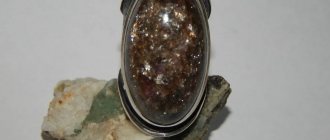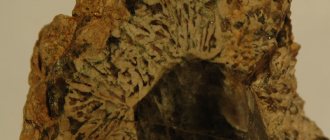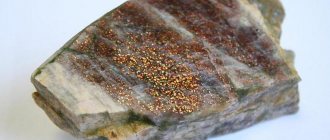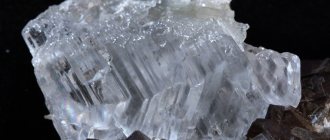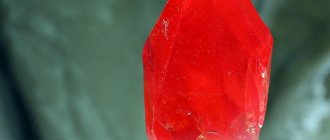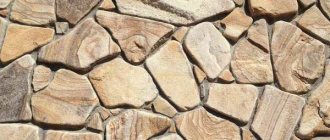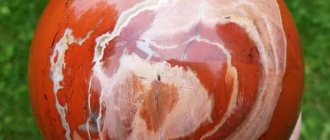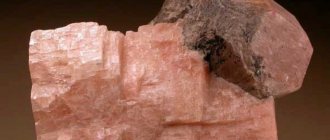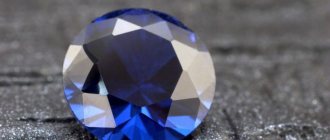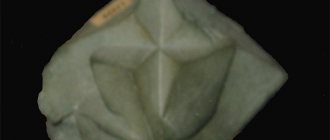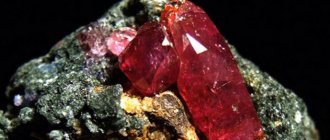Feldspar is such a common group of minerals that it makes up almost half the mass of the earth's crust. The name of this mineral from the class of silicates consists of the Swedish word feldt, which translates as “field”, and the German spath, i.e. "bar" or "plate". It is called field because it is often found on Swedish arable lands, which are located on moraine deposits. The feldspar mineral is characterized by good cleavage: when struck, it easily splits into plates, hence the “bar” in the name. Humanity has long found use for it in various industries, from industry to jewelry.
Story
Spars were formed as a result of volcanic eruptions, displacement of tectonic plates, exposure to wind and precipitation.
Two-thirds of the volume of the Earth's igneous rocks are minerals of the feldspar group. There are many of them on the Moon and in meteorites. Along with quartz, this is the most common rock on Earth.
The term “feldspars” refers to a group of four dozen minerals.
This is a Swedish-German tracing paper: “spat” is translated from German as a layered, plate-like stone (due to the presence of mica, the crystals are stratified into thin shiny plates); feldt - field, arable land in Swedish, feld - in German.
Used as a scientific term since the 18th century.
Archaeologists find jewelry and household utensils made of feldspars during excavations in Egypt and Asia (at the site of ancient Mesopotamia).
Even the ancient Chinese, who invented porcelain, added spar powder to clay to give strength to dishes, decorative vases and figurines, which made them famous throughout the world.
Physico-chemical characteristics
From a chemist's point of view, spar is a silicate.
Feldspars are united in a group by their origin, the presence of aluminosilicate in the composition, the similarity of the crystal lattice and the white color of the trait.
| Formula | { K, Na, Ca, sometimes Ba }{ Al2Si2 or AlSi3 }O8 |
| Color | White to bluish or reddish |
| Stroke color | white |
| Shine | Glass |
| Transparency | Translucent to transparent |
| Hardness | 5—6,5 |
| Cleavage | Perfect |
| Density | 2.54—2.75 g/cm³ |
| singonia | Monoclinic or Triclinic |
| Refractive index | 1,554—1,662 |
The basic formula includes oxides of calcium, sodium, aluminum, and silicon. They can be replaced and supplemented by impurities of chromium, nickel, iron, and copper. As a result, the white crystals take on color.
Orthoclase
Monoclinic feldspar orthoclase is given its name by its cleavage at an absolutely right angle - potassium aluminosilicate. Although orthoclase is mainly found in the form of irregular grains in igneous rocks, it is capable of producing tabular crystals with one developed face strictly parallel to the lateral pinacoid. Twins are often encountered, especially of the Carlsbad type, in which there is a rotation around the twin axis with a fusion plane passing along the lateral pinacoid.
These stones are usually light in color, mostly white, sometimes pink or red (due to scattered hematite particles), and occasionally gray or yellowish. Orthoclase differs from other stones in its low density. A colorless, transparent or translucent variety of orthoclase in the form of crystals that resemble rhombohedrons is known as adularia; if it has a soft blue iridescence, it is also called moonstone.
Place of Birth
Feldspars, as rock-forming minerals, form the basis of all continents, including Antarctica. They account for half the mass of the earth's crust.
Raw materials for technical purposes are mined everywhere, unlike jewelry material:
- The most beautiful moon rocks are found in the Pamirs.
- Orthoclase is the heritage of Asia and Europe.
- Germany, India, and China have established industrial production of Labradorite. But the most expensive samples are the pride of Finland.
- India and South America are rich in Amazonites of premium quality. But these are isolated cases: serious production is taking place in the Russian North and in the Baikal region.
The planetary volume of production of technical spar raw materials amounts to billions of tons.
The deposits of Madagascar, Germany, the USA, the Russian Federation, Poland, Ukraine, and Kazakhstan differ in scale.
Best time to buy
In order for stones to more fully demonstrate their healing and magical properties, you need to purchase them and start wearing them at the most favorable time.
| Name of mineral | Time (lunar day) | |
| Purchase | Accession | |
| adularia | 2 | 16 |
| belomorite (albite) | 14 | 28 |
| Labrador | 5 | 19 |
Colors and varieties
Mineralogists distinguish the following varieties of feldspars:
- Potassium feldspars. Calcium in the composition is replaced by potassium. Typical representatives are adularia, orthoclase, sanidine, microclines (including amazonite). Orthoclase is translucent, sometimes completely transparent, painted in gray-pastel colors.
Orthoclase - Calcium. Spars with inclusions of calcite, sodium appears in the crystal lattice. Also known as plagioclases. Jewelry types – labradorite, andesine, heliolite, albite (rare). They are distinguished by their bright colors and iridescent surface (especially Labradorite). Graphic pegmatite is coveted by collectors.
Labrador - Potassium-barium feldspars . The most famous is Celsian. This green or greenish-brown stone is very rare, found as inclusions in metamorphic rock. However, it is opaque, so it is sought after only by collectors, but not by jewelers.
Their abundance determines the presence of almost all colors in the minerals of the feldspar group: from bluish-black labradorite to golden heliolite.
Practical use
Feldspars are of great practical importance. Feldspathic raw materials are used in various industries as fluxing, aluminous, alkaline or aluminous-alkaline components, as well as inert fillers. Preferred are feldspathic rocks containing K2O + Na2 O more than 7 wt.%, CaO + MgO no more than 2, Al2O3 more than 11 and SiO2 63-80%. Therefore, mainly acidic (less often medium, alkaline) aluminosilicate igneous, metamorphic or sedimentary rocks of feldspar, quartz-feldspathic, kaolinite-feldspar-quartz or nepheline-feldspathic composition are used as raw materials. Basic and ultrabasic rocks are practically not used. Global reserves and resources of feldspathic raw materials have not been estimated. In Russia they currently amount to 115 million tons (52% of the reserves of the CIS countries); of which 88 million tons (76%) are granite pegmatites. World production of feldspar raw materials is 5 million tons/year: Italy - 1500, USA - 700, France - 400, Germany - 330, Thailand - 330, South Korea - 240, Mexico - 200 thousand tons. In world production of CIS countries - 10 -15%, of which the share of Russia is about 48%, Kazakhstan - 30, Ukraine - 15, Uzbekistan - 7%. The main volume of production in Russia comes from Karelia and the Murmansk region. Based on the quartz content, the raw materials are divided into feldspar proper (less than 10% quartz) and quartz-feldspar (more than 10% quartz); according to the ratio of alkalis - to high-potassium (“potassium module” = K2O/Na2O > 3 wt.%), used in the electrical and abrasive industries, as well as for the production of welding electrodes, potassium (“module” at least 2), used in electrical and abrasive industries porcelain-faience industry, potassium-sodium (“modulus” not less than 0.9), used for the production of building ceramics, and sodium (“modulus” less than 0.9 or not standardized), used in the glass industry and for the production of enamels such as “vitreous porcelain” " If nepheline is present, nepheline-feldspathic raw materials are isolated. High-potassium feldspar materials (with a high “potassium module” - above 4, low content of CaO and MgO - no more than 1.5% and FeO and Fe2O3 - no more than 0.15-0.30%) are used in electroceramic production for the manufacture of high-voltage porcelain insulators, as a flux and adhesive mass for the production of grinding and sharpening abrasive products, for ceramic coating (slag-forming products that stabilize the arc) in the production of welding electrodes, in the porcelain and earthenware production for the production of transparent glaze coatings (“module” no less than 3). Feldspar and quartz-feldspathic materials with a high “potassium module” (2-3 and above 3 for products of the highest brands) are used in the ceramic industry as flux for the production of fine ceramics (household and artistic porcelain, electrical porcelain), potassium-based sodium quartz-feldspar materials (with a low “modulus” of up to 0.9) - for the production of building ceramics (sanitary ceramics, facing and finishing tiles), and sodium feldspars (with a non-standardized “modulus”) - for the production of low-temperature porcelain. Quartz-feldspathic and nepheline-feldspathic materials are also used as a charge for the production of electric vacuum and high-grade technical glass, sheet technical and window glass and products from dark green and container glass. Sodium feldspathic materials are used for enamel coatings of cast iron and iron products to increase their viscosity and chemical resistance.
Feldspars are used as a filler in the paint and varnish industry (the resulting paints are more resistant to acid rain and sunlight than with carbonate fillers and are used for outdoor work), in the rubber industry, in the production of opalescent glass, tiles, tiles, concrete, cement , in dentistry for the production of artificial teeth, etc. New areas of application of feldspars (mainly from low-quality and substandard feldspathic and nepheline-feldspathic materials, which is important when solving environmental problems and complex development of deposits) are the production of glass-crystalline materials (ceramic glass and slag glass). , used in construction, chemical, mining and electrical industries), thermal insulation materials (foam glass used in construction to insulate walls and floors, refrigerators, etc.), as well as binding materials (pozzol and other new cements) obtained from sishtof (a glass-like mass with an admixture of microcline, aegirine and other associated minerals) and sulfate-alkaline fertilizers obtained from phosphogypsum - industrial waste generated during acid (with H2SO4) processing of Khibiny apatite-nepheline ores during the production of phosphate fertilizers. Nepheline-feldspathic materials are used to produce engobe - a ceramic mass baked in the form of glazes to lightweight concrete products (wall panels, etc.).
In recent years, feldspars have attracted attention in connection with the problem of radioactive waste disposal. Instead of the common vitrification technology, fixation of radioisotopes 90Sr, 134Cs and 137Cs in polymineral matrix materials consisting of Sr-containing feldspar with a quartz shell or pollucite with a shell of K,Na-feldspar is proposed; these materials are more resistant to leaching than glass.
Where are feldspars used?
Depending on their appearance and condition, feldspars are sorted by industrialists, jewelers and collectors.
Industry
Opaque, nondescript stones have found application as industrial raw materials:
- This is a source material for the production of glass, ceramics, and building materials.
- The production of electrical products (cables, insulators) and plumbing equipment cannot be done without spar.
- Composite materials based on feldspars are used in all areas of mechanical engineering, including defense, space and high technology.
- The mineral is used in welding, metallurgy, and construction (ore, mineral paints, rubber, cladding).
Feldspar is used to make light abrasives for cosmetics and perfumes (toothpaste, scrubs, soap).
Jewelry
Jewelers are in demand for translucent and transparent varieties: adularia, amazonite, andesine, heliolite (or sunstone), labradorite.
Amazonites
They are used to make original jewelry or used as an imitation of more expensive stones.
Artificial production of mineral
The synthesis of alkali feldspars of the composition (Na, K, Rb, NH4)[(Al, Ga, Fe, B)(Si, Ge)3 O8] is usually carried out from glasses of stoichiometric composition dry (at a temperature of 700-1000 °) or hydrothermal ( for example, 550°, 1 kbar, 140 h) by. For the first time, artificial analogs of feldspars of the compositions NaGaSi3O8, NaAlGe3O8, NaGaGe3O8 (triclinic) and KGaSi3O8, KAlGe3O8, KGaGe3O8 (monoclinic) were obtained in [32], monoclinic RbAlSi3Og - in [33]. It was not possible to synthesize feldspar with the composition NaFeGe3O8 (instead, pyroxene with the composition NaFe[Ge2O6] crystallized under hydrothermal conditions, and instead of CsAlSi3O8, pollucite crystallized. It was assumed that Cs-no-feldspars cannot exist due to the too large size of the Cs atom, as well as Li-feldspars, but, on the contrary, due to the too small size of the Li atom (Smith, Brown, 1988).However, monoclinic CsAlSi3O8 was still obtained by ion exchange between analbite or sanidine and a molten salt CsCl. Lithium feldspars were synthesized in a similar way , hydrogen and silver: LiAlSi3O8, HAlSi3O8 and AgAlSi3O8. Feldspars of the composition K[Al2PSiO8] have also been synthesized.
Diagnostic signs
Orthoclases are associated with quartz, felsic plagioclase, muscovite, biotite and hornblende. Anorthoclase - Ti-augite, apatite, ilmenite. Plagioclases - spessartine, rhodonite, Mn - epidote, sanbornite, jillespite.
How to spot a fake
Almost all spars are inexpensive, they are rare, but they are counterfeited:
- More often they use glass with copper particles (it becomes similar to heliolite). Interspersed with chrome or nickel imitate labradorite.
- However, the iridescence is not so bright, and the shine when turning is uneven, the imitation looks poorer in color.
- To identify a sample, you hold it in your hands - the stone will not heat up immediately and will be massive. Light will refract in a vessel with water.
Any spar can easily scratch glass.
It is only possible to accurately determine the origin of a sample using special equipment, so it is better to buy jewelry from trusted sellers.
The stars speak
According to the zodiac sign, Amazonites will bring great benefits to Libra, Capricorn, Virgo, and Pisces.
Adularia is a gem for Cancers and Pisces. But these zodiac signs are not recommended to wear jewelry with adularia on the waning Moon. Esotericists say that at this time the moonstone needs energy. And he will pull it wherever possible. And the closest one is usually the owner...
The gem is contraindicated for fire signs.
The sun stone will gladly help any zodiac sign to heal. The magical properties of heliolite are most suitable for the Fire signs: Leo, Aries, Sagittarius.
The stone is least suitable for Water signs, but it will not cause harm - it will be a simple decoration.
Labradors have a weakness for Water signs. Therefore, Pisces, Cancers, Scorpios will receive any help that the stones can provide.
The stone is indifferent to other signs of the Zodiac.
How to care
Feldspars do not require special care:
- An ordinary box is enough for storage.
- Dirt is removed with warm water and a light detergent.
- Dry with a paper towel or soft cloth.
Once every six months, you can do a general cleaning in a solution of water, detergent and ammonia - proportion 200:30:20 ml. The products are left for 10–15 minutes, after which they are rinsed with clean water and dried with a napkin.
Small plastic made of mineral requires care. You need to place it so that it doesn’t fall and no one hits it.
Plagioclases
The feldspar mineral also has another group - plagioclases (sodium-calcium triclinic feldspars), which form a constant series from sodium albite plagioclase to calcareous anorthite plagioclase.
Plagioclases are almost always twinned. Since this twinning is repeated many times in each sample (twins), the planes of this basal cleavage of plagioclases are covered on top with thin parallel streaks, which represent traces of contacts between twinned rocks and the emergence of twinned sutures to the surface.
Price
Industrial spar raw materials are sold on the world market at $85–105 per ton. They charge even more for sanidine, an essential component of elite “bone” china.
Russian stores offer to buy jewelry and collectibles from all over the world (price/rub.):
- heliolite (bead, diameter 2 mm) – 92;
- amazonite (30x45x43 mm, India) – 1,800;
- sanidine (36x13x18 mm; Madagascar) – 820;
- microcline (43x25x41 mm, Kola Peninsula) – 200.
The most expensive of jewelry spars is heliolite. Prices for jewelry with such inserts are thousands (silver) or tens of thousands (gold) rubles.
Areas of use
The stone is used not only in the manufacture of jewelry, but also in such areas as:
- used in the manufacture of ceramic and glass products, paint, rubber;
- used to produce aluminum, rubidium;
- taken to create light abrasives used in cosmetology and soap making;
- used for the manufacture of insulators and electrodes;
- mineral bars serve as an excellent facing material.
The precious mineral is used in the manufacture of jewelry and costume jewelry. Green and blue specimens are placed in a silver frame or in alloys containing silver. As a rule, gold contains a yellow or red mineral.
Medicinal properties
The healing properties of feldspars have been thoroughly studied:
- Andesine neutralizes depression or suicidal tendencies.
- Amazonite improves the functioning of the heart and the state of the central nervous system.
- Heliolite is beneficial for blood and skin.
- Labradorite normalizes the functioning of the musculoskeletal system and restores reproductive functions.
- Adularia and orthoclase relieve attacks of epilepsy, inhibit oncology, and relieve depression.
Only natural and whole specimens are suitable for medicinal or magical purposes.
Compatibility with other stones
Adularia, labradorite and amazonite are friendly with each other and feel great next to each other.
- Other stones that would be good neighbors for adularia are: belomorite, lapis lazuli, white pearl, onyx, coral, obsidian. You should not wear it with agate, garnet, jasper, malachite, ruby.
- Suitable for Labrador: aquamarine, opal, lapis lazuli, malachite. Not compatible with diamond, ruby, garnet.
- Ideal partners for Amazonite would be: aquamarine, rauchtopaz, fire opal, jasper, rock crystal. Does not combine with agate, black and white sardonyx, morion, onyx.
- Belomorite is well compatible with adularia, as well as with mother-of-pearl and pearls.
Magic properties
The magical properties of feldspar group minerals are determined by the type of stone:
- Labrador. Used by esoteric practitioners to develop paranormal abilities, communicate with otherworldly forces, or travel through time. At the everyday level, it replenishes the body’s reserves, helps develop intuition and a thirst for knowledge. However, the stone “loves” older people more.
Ring with labradorite - Adularia, orthoclase. Needed to achieve or maintain a home microclimate, love.
Orthoclase 10.34 carats
By changing its color, orthoclase warns of adultery or impending unfavorable changes.
- Amazonite It is important as a talisman of family ties. It also inspires self-confidence, makes you bolder and more assertive. But caution is needed: a person can become rude or rowdy.
Amazonite bracelet - Moon rock – an attribute of creative people and public figures. It will help you concentrate, express your thoughts clearly, and maximize your talents. Or become a psychic.
Moon rock
All spars protect a person from envy, damage, and other manifestations of dark energy.
Lithotherapists advise
Products made from some varieties of the mineral (according to lithotherapists) have healing properties.
Amazonite is used for massages (anti-cellulite and general). The stone will help with osteochondrosis and arthritis, normalizes metabolic processes. Wear Amazonite jewelry regularly if you have dermatitis or eczema.
Amazonite
In the old days, it was believed that jewelry with amazonite healed the heart, thyroid gland, and lungs.
Labradorite (according to lithotherapists) will alleviate colds, strengthen the immune system, and help cure diseases of the genitourinary system.
Labrador
Important for many: lithotherapists believe that the mineral normalizes blood pressure and heals blood vessels. We recommend: JADEITE - the imperial stone or a successful investment
Sun stone (heliolite) is recommended for older people. It is recommended to wear jewelry at all times. Lithotherapists believe that the stone gives vigor and increases vitality. The stone has a tonic effect.
Heliolite
adularia in the East has been a stone that continues the family line. More precisely, he helped women get pregnant. After all, the main thing (from the point of view of an Eastern person) is to leave its continuation on earth. A moonstone amulet protects travelers.
Adularia
But the stone is not simple. He does not like duplicity, lies, deceit. Give jewelry with adularia to harsh, tough, cold people. The mineral will help awaken the warmth of the soul and compassion for others in the owner of the jewelry.
